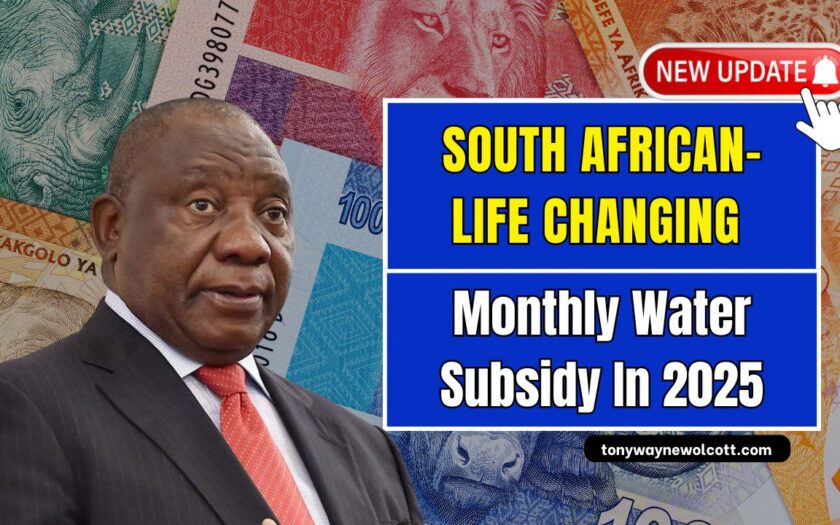Imagine a relief so impactful it transforms daily life for millions—households across South Africa are on the cusp of receiving a monthly water subsidy beginning in 2025. This game‑changing policy promises to drastically reduce the burden of rising water tariffs and ensure access to essential water remains affordable.
In this article, we dive deep into who qualifies, what’s being offered, how it will roll out, and the staggering figures, benefits, and timelines behind this massive relief effort.
What’s the Subsidy?
- 6 kilolitres (6 000 L) of free water per household per month – the foundation of the subsidy, aligning with the ongoing Free Basic Water policy administered by municipalities nationwide. This allotment is specifically intended for indigent or low‑income households, though criteria vary across regions.
- Subsidy on the “basic charge”—some municipalities (e.g., George Municipality) go further by offering a 50 % subsidy on the monthly basic water charge, along with the free 6 kl.
- Exemptions: In areas like Mangaung, households with a property market value of R100 000 or less and registered indigent households are exempted from basic availability charges, adding to the relief.
Why It Matters Now
- Rising tariffs: As of July 2025, residential water tariffs have increased by around 11 %, with the 0–6 kl consumption slab rising from R11.97 to R13.28 per kl (or R15.27 including VAT). Other slabs saw similar hikes, and the basic availability charge has risen from R47.52 to R52.75, all VAT inclusive.
- Slipping free‑service coverage: Even with expanded municipal delivery, only 16 % of consumer units received free basic water in 2023, down from 17 % in 2022—highlighting persistent gaps in policy reach and enforcement.
- Infrastructure investment surging: Billions are being pumped into water supply upgrades—projects like Mandlakazi (R4.9 billion) servicing over 33,000 households, and the Ngqamakhwe scheme (R792 million) reaching 78,000 people—ensure subsidy rollout aligns with system capacity.
Key Details
| Feature | Details / Figures (2025) |
|---|---|
| Free Basic Water per Household | 6 kl per month (~6,000 L) |
| Additional Subsidy (Basic Charge) | 50 % rebate on basic monthly charge in some municipalities (e.g., George) |
| Exemption Thresholds | Market value ≤ R100,000 or registered indigent households (e.g., Mangaung) |
| Tariff Increase (0–6 kl slab) | From R11.97 → R13.28 per kl (+11 %) (VAT incl. R15.27) |
| Basic Availability Charge | From R47.52 → R52.75 per month (+11 %) (VAT incl. R60.66) |
| Free Service Coverage (2023) | 16% of consumer units received free basic water |
| Infrastructure Spending Examples | Mandlakazi (R4.9 bn, 33,000 households) Ngqamakhwe (R792 m, 78,000 people) |
How the Roll‑Out Works
- Municipality‑specific implementation
Each municipality decides how to apply the 6 kL free water and subsidies—opting for universal access, targeting only the poor, or adding rebates on top. Qualification criteria (e.g., income thresholds, property value, indigent registration) vary by local policy. - Integration with tariff reforms
Subsidies are designed to offset rising tariffs. For example, the 11% hike in tariffs and basic charges is counterbalanced for eligible households by the free 6 kL and partial rebates. - Infrastructure readiness
Major bulk water schemes funded by grants ensure sustainable supply growth aligns with subsidy expansion. These include the Mandlakazi, Ngqamakhwe, and similar projects targeting underserved areas. - Ongoing review and flexibility
Coverage and financial design remain dynamic, adjusting based on budget availability, equitable share transfers, and actual need assessment across yearly cycles.
South Africa’s bold push to roll out a monthly water subsidy in 2025 marks a monumental step towards easing the burden on struggling households.
Through the delivery of 6 kL of free water, targeted basic‑charge rebates, and strategic exemptions, municipal governments are delivering both lifeline support and financial relief.
Coupled with massive infrastructure investments, this initiative is poised to improve water access, affordability, and equity across the nation.
As implementation unfolds, success will hinge on local policy execution, funding stability, and sustained alignment between subsidy schemes and service delivery upgrades.
FAQs
Who qualifies for the monthly water subsidy?
Indigent or low‑income households that meet criteria like income thresholds, property value limits, or formal indigent registration. Some municipalities also extend relief to households with property values under R100,000.
How much water is provided, and is it truly free?
Yes—qualifying households receive 6 kL (6,000 litres) of water per month for free. In certain municipalities, they also get a 50% waiver on the basic monthly water charge, and may be exempt from availability fees.
Isn’t water getting more expensive? How does this subsidy help?
Indeed, tariffs rose by approximately 11% in 2025, including higher consumption rates and availability charges. The subsidy neutralizes this impact by providing free water and rebates, making water affordable for vulnerable households.

